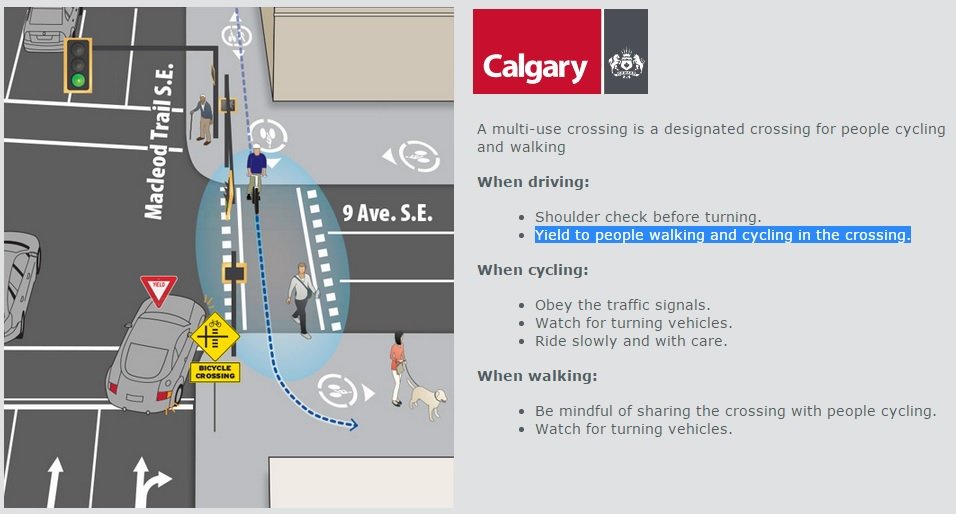The Zoning Bylaw section 54.3 covers bicycle parking. You can also learn more about bike racks and bike parking, including purchasing information, on our Bike Racks page.
City Council and Committee Meetings
Bylaw C8353: Conduct of Transit Passengers
The purpose of this bylaw is to regulate the conduct and activities of people using the Edmonton Transit System in order to promotethe safety and welfare of other users of the Edmonton Transit System.
Notes
For more information about bikes on transit, including the hours for bikes on LRT and bus routes with bike racks, please see our Bikes on Transit page.
BICYCLES 27
- A person shall not carry a Bicycle aboard a Transit Vehicle except:
- during the hours specified by the City Manager;
- in the areas specified by the City Manager; and
- while under control.
- A person shall not leave a Bicycle unattended in a Transit Station or aboard a Transit Vehicle except in a location designed and intended for the storage of Bicycles.
- A person shall not allow a Bicycle under their control to bring dirt, mud or grease into a Transit Station or onto a Transit Vehicle
Bylaw 5590: Traffic Bylaw
The purpose of this bylaw is to regulate the use of highways under the direction, control and management of the City and to regulate the parking of vehicles on such highways as well as on privately owned property.
Notes
Bicycles are allowed on all highways in Edmonton. This includes roads on private property that normally permit the public to use for passage or parking.
“sidewalk” means that part of a highway especially adapted to the use of or ordinarily used by pedestrians, and includes that part of a highway between:
the curb line, orwhere there is no curb line, the edge of the roadway, and the adjacent property line, whether or not it is paved or improved;
“highway” means any thoroughfare, street, road, trail, avenue, parkway, viaduct, lane, alley, square, bridge, causeway, trestleway or other place, whether publicly or privately owned, any part of which the public is ordinarily entitled or permitted to use for the passage or parking of vehicles, and includes:
a sidewalk, including a boulevard adjacent to the sidewalk,if a ditch lies adjacent to and parallel with the roadway, the ditch, andif a highway right of way is contained between fences or between a fence and one side of the roadway, all the land between the fences, or all the land between the fence and the edge of the roadway, as the case may be,
but does not include a place declared by regulation not to be a highway;
MATERIAL ON SIDEWALKS/ROADWAYS48 A person shall not place, cause or permit to be placed any earth, sand, gravel, grass, leaves, snow, ice or other material upon any sidewalk or roadway.
BICYCLES49
A person shall not ride a bicycle on any sidewalk.This section does not apply:if the bicycle has a wheel diameter of 50 centimeters or less; orif the sidewalk is designated as a bicycle path.
BICYCLE CONDUCT50 A person riding a bicycle on a sidewalk or bicycle path shall:
yield the right of way to slower moving people;alert anyone about to be overtaken by sounding a bell a reasonable amount of time before overtaking;use reasonable care when overtaking another person; andtravel under control and at a reasonable rate of speed having regard to the nature, condition and use of the sidewalk or bicycle path including the amount of pedestrian traffic.
Crosswalks
“crosswalk” means:
that part of a roadway at an intersection included within the connection of the lateral line of the sidewalks on opposite sides of the highway measured from the curbs, or in the absence of curbs, from the edges of the roadway; orany part of a roadway at an intersection or elsewhere distinctly indicated for pedestrian crossing by traffic control devices or by line or by other markings on the road surface;
This means that crosswalks do not have to have any kind of signage to be considered a crosswalk. e.g. the following is a crosswalk, and pedestrians have the right of way, even though it is not explicitly marked or signed in any way (the green lines have been added digitally):
Alberta Regulation 304/2002 of the Traffic Safety Act states:
Yielding to pedestrians41
A person driving a vehicle shall yield the right of way to a pedestrian crossing the roadway within a crosswalk.Where a vehicle is stopped at a crosswalk to permit a pedestrian to cross the roadway, a person driving any other vehicle that is approaching the stopped vehicle from the rear shall not overtake and pass the stopped vehicle.At any place on a roadway other than at a crosswalk, a person driving a vehicle has the right of way over pedestrians unless otherwise directed by a peace officer or a traffic control device.Nothing in subsection (3) relieves a person driving a vehicle from the duty of exercising due care for the safety of pedestrians.
There is currently no section in the Edmonton Traffic Bylaw 5590 or the Alberta Traffic Safety Act specifically dealing with cyclists in crosswalks. Cyclists are not legally required to dismount at crosswalks and there is nothing to prohibit a cyclist from riding along a crosswalk.
In terms of the operations of a crosswalk, as stated in the Alberta TSA “Use of Highway and Rules of the Road Regulation” Part 2, Division 4 (75): “A person driving a vehicle shall yield the right of way to a pedestrian crossing the roadway within the crosswalk.”
Therefore, only if a cyclist dismounts and is therefore considered a pedestrian and not a vehicle by law, do they obtain the right-of-way over motorists.
If a cyclist chooses to ride their bike along the crosswalk, they are considered a vehicle. The crosswalk only serves to provide protection for pedestrians.
This does not excuse vehicles from exercising due care and taking reasonable efforts to avoid collisions (regardless of right of way), but they are not legally obligated to yield to a cyclist who rides through a crosswalk merely because of the presence of a crosswalk. On the other hand, other controls, such as a yield or stop sign, would still require a driver to yield to both pedestrians and cross traffic, meaning even without dismounting a person would still have the right of way over vehicle traffic.
Note that in the case of a cyclist riding on a sidewalk (where cyclists aren't normally allowed), while riding across the crosswalk may not be illegal, if riding on that sidewalk is illegal, in the case of a collision the cyclist would likely be found to have contributed to the collision. And in all cases, all road users must exercise due care for themselves, regardless of right-of-way, and the specific final determination of fault in a collision would come down to the courts. None of the material here is to be taken as legal advice.
The City of Edmonton typically encourages cyclists to dismount, especially at busier intersections. We must address all cyclists and their varying levels of skill and comfort.
The status of riding in crosswalks can vary. For instance, in Calgary, but not Edmonton, people riding bicycles across multi-use crossings have the right of way just as any pedestrian:
Calgary Bylaw 26M96MULTI-USE CROSSINGS41.1
The Traffic Engineer may designate crosswalks upon which a person may ride a bicycle to cross the roadway.Where the Traffic Engineer has designated a crosswalk pursuant to subsection (1), any crosswalk so designated shall be known as a “multi-use crossing”. The Traffic Engineer shall indicate the multi-use crossing by the placement of such traffic control devices as the Traffic Engineer deems necessary.A person operating a vehicle on a roadway must yield the right of way to: a pedestrian; anda person riding a bicycle;who is crossing the roadway within a multi-use crossing.When crossing a roadway within a multi-use crossing: a pedestrian; ora person riding a bicycle;has the same rights and obligations of a pedestrian using a crosswalk.
Bylaw 2202: Parkland Bylaw
Covers activities in City parkland, including many shared-use paths in the river valley. The purpose of this bylaw is to regulate the conduct and activities of people on Parkland in order to promote the safe, enjoyable and reasonable use of such property and to protect and preserve natural ecosystems for the benefit of all citizens of the City.
Notes
TRAIL USE 12
- Every person using an Improved Trail or an Unimproved Trail shall:
- yield the right of way to slower moving people;
- alert anyone about to be overtaken by giving an audible signal a reasonable amount of time before overtaking; and
- use reasonable care when overtaking another person.
- Every person using a Bicycle on an Improved Trail or an Unimproved Trail shall alert anyone about to be overtaken by sounding a bell a reasonable amount of time before overtaking;
SPORTING ACTIVITIES 14.1 While on Parkland no person shall operate a Bicycle unless the Bicycle is equipped with a working bell.



